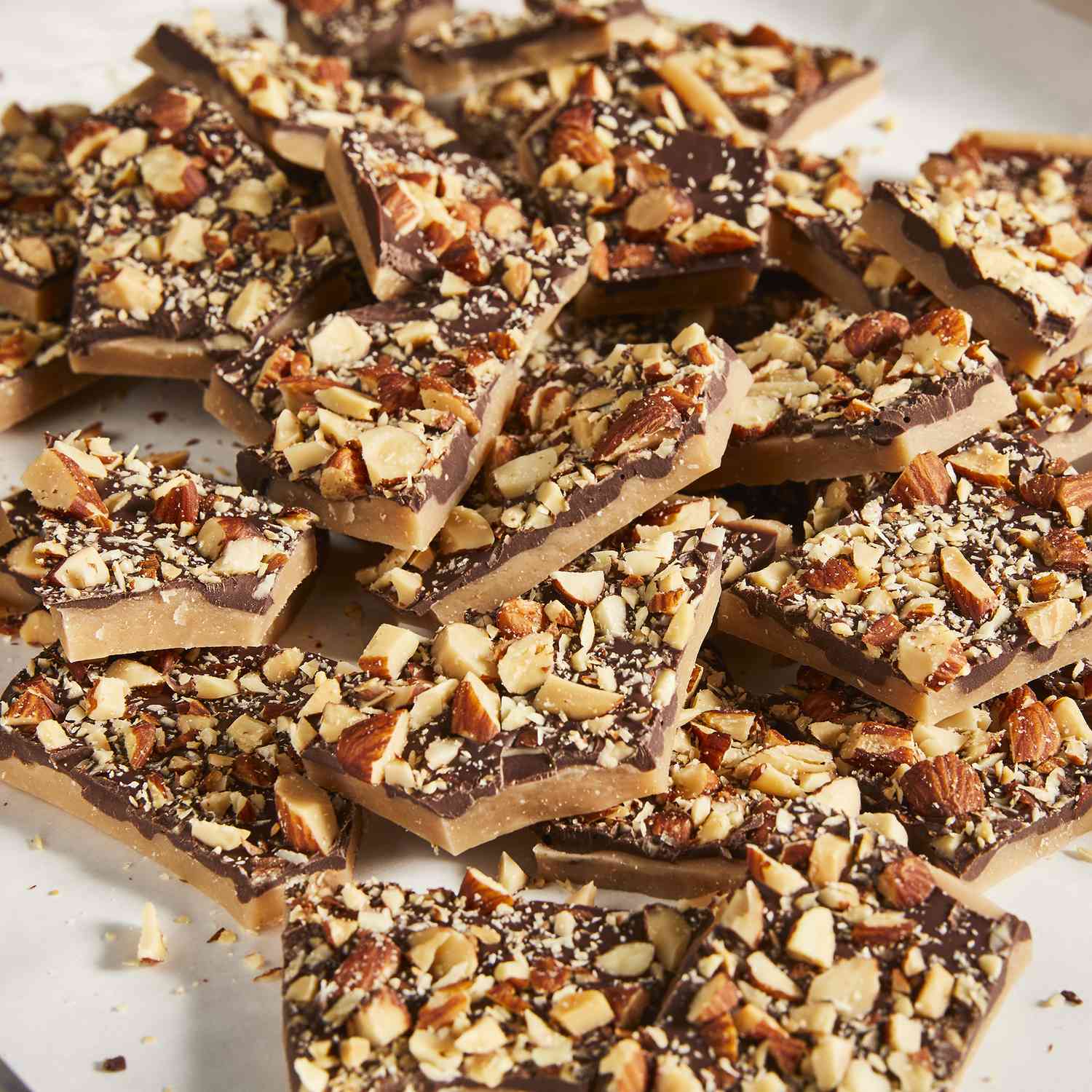Welcome to the Sweet World of Toffee!
Hey there, wonderful parents! If you’re on a scrumptious quest to understand the ins and outs of toffee for the sake of your little ones, then you’ve come to the right place. Toffee, that buttery, caramelized sugar treat, is a classic favorite among children and adults alike. But what is it about toffee that captures our hearts (and taste buds)? In this ultimate guide, we’ll unwrap the sweetness of toffee, look into its history, explore types, and even share some tooth-friendly tips. Get ready for a delightful dive into the sticky, sweet world of toffee!
What is Toffee, Exactly?
First off, let’s sink our teeth into what toffee is. Toffee is a type of confection made by boiling sugar and butter together until it reaches the hard crack stage, resulting in a glossy, rich, and often nutty-flavored treat. Depending on where you are in the world, the term “toffee” might mean different things. For instance, in the US, toffee usually has a hard, snappy texture, while in the UK, it’s often chewier. But no matter its consistency, it’s the buttery and sweet flavor that has everyone hooked.
A Brief Toffee History
Now, let’s take a quick trip down memory lane. Toffee’s origins are a bit sticky, as its history is as rich and complex as its flavor. The word “toffee” is thought to come from the word “taffy,” which has its roots in the 19th century. However, the exact origins of the toffee we know today are shrouded in caramelized mystery. Some stories suggest that toffee was invented in the early 19th century in England, while others claim its heritage from earlier sugar confections. Whatever its history, toffee has become a global phenomenon, enjoyed by sweet tooths from all around the world.
Types of Toffee to Delight
Prepare to be dazzled by the variety of toffee out there! When it comes to types, there’s a toffee for every preference:
- Classic Butter Toffee: This traditional toffee is smooth, rich, and usually coated with chocolate and sprinkled with nuts.
- Chewy Toffee: For those who love a good jaw workout, chewy toffee provides a stick-to-your-teeth experience that lasts a bit longer.
- Brittle Toffee: Similar to peanut brittle, this type of toffee is hard and often filled with nuts like almonds or peanuts.
- Salted Caramel Toffee: A modern twist on classic toffee, this version adds a touch of salt to enhance the sweet caramel flavor.
- Honeycomb Toffee: Also known as sponge toffee, it’s light, airy, and has a crunchy texture that is simply irresistible.
Each type offers a unique taste and texture, so feel free to explore and find your family’s favorite!
Toffee vs. Caramel: A Sweet Showdown
Often confused with each other, toffee and caramel are distinctively different treats, though both are equally delicious. The primary difference lies in their cooking stages and ingredients. Caramel is typically made with sugar, butter, cream or milk, and is cooked to the soft-ball stage, giving it a soft, gooey texture. Toffee, on the other hand, omits the cream and reaches the hard-crack stage in the cooking process, resulting in a harder, more brittle candy.
Toffee in Your Child’s Diet: Balancing Fun and Health
As parents, we all want to balance fun treats with healthy choices for our kids. While toffee is undeniably a treat, there are ways to include it in your child’s diet responsibly:
- Moderation is Key: Ensure that toffee is enjoyed in moderation. It’s high in sugar, so it should be a sometimes-food rather than an everyday treat.
- Teeth-Friendly Practices: Encourage good dental hygiene, especially after enjoying toffee, to prevent tooth decay and cavities. Brushing teeth or rinsing the mouth after eating toffee can help.
- Alternative Ingredients: Look for toffees made with natural sugars or sugar substitutes for a slightly healthier option.
While toffee is a delight, it’s also important to ensure we’re keeping our kiddos happy and healthy with a well-rounded diet.
Ready for Some Toffee DIY?
Why not make your own toffee at home? Homemade toffee can be a fun family activity, and it allows you to control the ingredients to suit your family’s preferences and dietary needs. Plus, it’s easier than you might think. Stay tuned as we’ll soon share tips and a simple recipe for creating your own buttery bliss right in your kitchen!
Toffee is more than just a candy; it’s a versatile treat that can bring a little extra sweetness to any occasion. As you continue this guide, we’ll go more in-depth about the incredible ways you can incorporate toffee into your family’s life, from recipes to creative crafts, and educational fun. Toffee can truly be a way to create sweet memories with your kids!

5 Things Parents Should Know When Preparing Toffee
1. Understanding Cooking Stages is Crucial
When it comes to making toffee, temperature is everything. Familiarize yourself with the candy thermometer and the critical stages of sugar cooking—from soft ball to hard crack. Toffee that hasn’t reached the hard crack stage will be too soft, while overheating can result in a burnt taste. Aim for a temperature between 300°F (149°C) and 310°F (154°C) for that perfect snap!
2. Quality Ingredients Make a Difference
The simplicity of toffee’s ingredient list means that the quality of each component will profoundly affect the final product. Choosing high-quality butter and sugar will not only improve flavor but also the texture of your toffee. Organic, grass-fed butter, and non-GMO sugar are great options for health-conscious parents.
3. Safety First: Candy-making Can Be Hot Business
Toffee-making involves boiling sugar to high temperatures, which can cause serious burns if not handled with care. Make this a parent-supervised activity, keeping young children at a safe distance from the stove. Always use oven mitts and be cautious when handling the hot mixture.
4. Customizing Your Toffee
One of the joys of homemade toffee is tailoring it to your family’s tastes. Feel free to experiment with different add-ins like nuts, dried fruit, or a pinch of sea salt. You can also opt for dark chocolate instead of milk chocolate for a richer flavor and added antioxidants.
5. The Science and Fun of Toffee-making
Not only is making toffee a chance to create something delicious, but it’s also an educational opportunity. Engage your kids in the science of candy-making: how sugar changes state, what causes the crystalline structure of toffee, and why precise temperatures are so important. Making toffee can thus become a fun science experiment that ends with a yummy reward.
Whether you’re a seasoned toffee connoisseur or a novice in the kitchen, understanding these key points will set you up for toffee-making success. And remember, the process is just as sweet as the result. Share the joy of cooking with your kids and create some magical, toffee-coated memories that stick with them for a lifetime!
Tools and Ingredients for the Perfect Toffee
Before you get started on your toffee adventure, let’s make sure you’ve got everything you need. Here’s a list of tools and ingredients that will make your toffee-making process a breeze:
- Candy Thermometer: A must-have for monitoring the temperature of your sugar mixture.
- Quality Saucepan: A heavy-bottomed saucepan ensures even heat distribution and prevents scorching.
- Wooden Spoon: Ideal for stirring your toffee, as it doesn’t conduct heat like metal spoons.
- Baking Sheet: A greased or parchment-lined baking sheet is where you’ll pour your toffee to cool and set.
- Butter: The star of the show, providing rich flavor and creamy texture.
- Sugar: The sweetness comes from good-quality granulated sugar.
- Optional Add-ins: Chocolate, nuts, or dried fruit for extra pizazz.
Armed with the right tools, and a sprinkle of patience, you’re all set to whip up a batch of homemade toffee that’s sure to be a hit with the whole family. Remember to get creative, enjoy the process, and, of course, savor the fruits of your labor – sweet, sticky toffee promises smiles all around!
For more great articles please see here. For more information see here
Disclaimer
The articles available via our website provide general information only and we strongly urge readers to exercise caution and conduct their own thorough research and fact-checking. The information presented should not be taken as absolute truth, and, to the maximum extent permitted by law, we will not be held liable for any inaccuracies or errors in the content. It is essential for individuals to independently verify and validate the information before making any decisions or taking any actions based on the articles.




